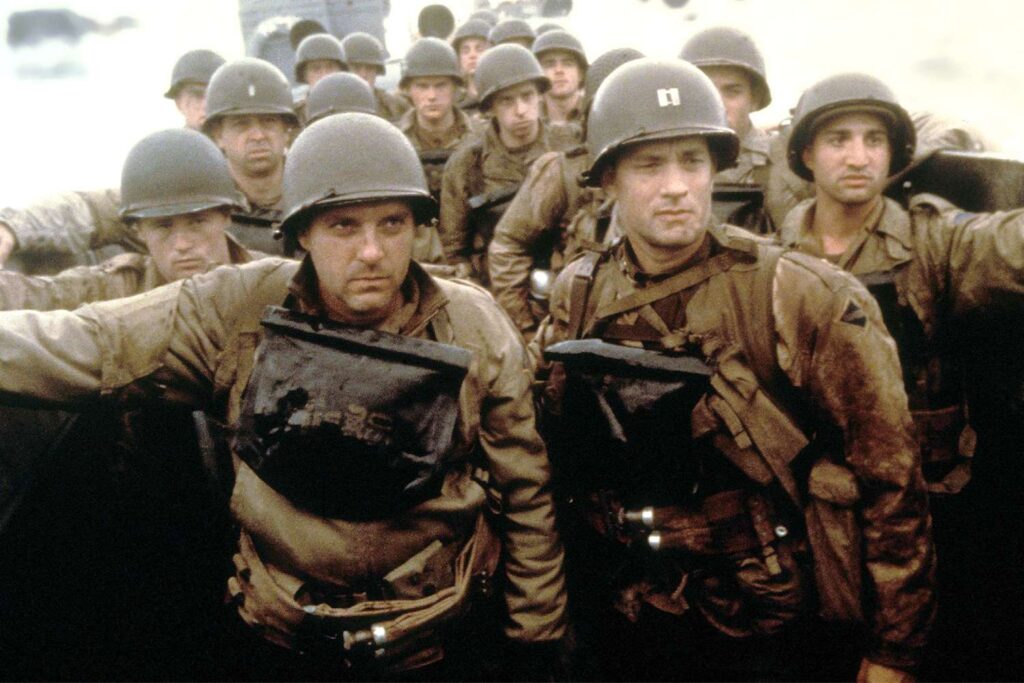Stephen Spielberg’s acclaimed film Saving Private Ryan has real-life roots in the story of four brothers.
The Oscar-winning 1998 war drama, which premiered 27 years ago, was inspired by Edward, Preston, Robert and Frederick “Fritz” Niland, four brothers from Upstate New York who all fought in World War II.
In the film, Matt Damon portrays Private James Francis Ryan, a character loosely based on Fritz. Captain John H. Miller (Tom Hanks) is tasked with leading his company to find Private Ryan — unaware that his three brothers have been killed — so he can be sent back home to his grieving family.
In real life, Edward was presumed dead after going missing in action (M.I.A.) in the Pacific theater in 1944, and Preston and Robert died within hours of each other in the D-Day invasion at Normandy. After the three tragedies, authorities found the fourth brother, Fritz, and pulled him from fighting duties to prevent the family from losing all four men in the war.
“They came together to conquer an unthinkable task and really showed the world that nothing is impossible with the American spirit,” James Niland told Buffalo’s WIVB in 2024 of his great-uncles. “Those men were legends, and it was a legendary triumph. They’ll live on forever.”
Saving Private Ryan debuted in theaters on July 24, 1998. The third highest-grossing U.S. film of 1998, the war drama was nominated for 11 Oscars and won five.
Here is everything to know about the real events that inspired the Oscar award-winning film Saving Private Ryan.
Is Saving Private Ryan based on a true story?
David James/Dreamworks/Amblin/Universal/Kobal/Shutterstock
Saving Private Ryan is a fictionalized account of a real story. It was inspired by the true tales of brothers Edward, Preston, Robert and Frederick “Fritz” Niland.
Damon portrays Private Ryan, who was based on Fritz. In the film, Hanks’ Captain Miller leads the crew of Company C (including Edward Burns, Giovanni Ribisi, Vin Diesel and the late Tom Sizemore) on a mission to locate Private Ryan after his three brothers are presumed dead.
The script, by Robert Rodat, was inspired by his reading of Stephen E. Ambrose’s books, as well as noticing multiple sets of deceased brothers on a monument to soldiers killed in American wars.
The Nilands’ story, among others, led to the creation of the military’s Sole Survivor Policy in 1948. Today, it is officially named Directive 1315.15 Special Separation Policies for Survivorship. It states that “service members who become surviving or sole surviving sons or daughters may apply for discharge or separation.”
Who were the Niland brothers?
Moviestore/Shutterstock
Edward, Preston, Robert and Frederick “Fritz” Niland were four brothers born to Michael and Augusta Niland in Tonawanda, N.Y.
Edward Francis was born on Dec. 22, 1912, followed by Preston Thomas on March 6, 1915. Robert Joseph joined the family on Feb. 2, 1919. The youngest brother was Frederick “Fritz” William, born on April 23, 1920.
All four brothers served in the U.S. Army and were deployed overseas during World War II. Preston, Robert and Fritz were part of the D-Day invasion in Normandy.
What happened to the Niland brothers during World War II?
Moviestore/Shutterstock
Edward, a technical sergeant, was the first to go missing. He was flying in a secondary mission over Burma when his B-25 Mitchell bomber was shot down on May 16, 1944. He was presumed dead and considered M.I.A.
Robert and Preston were killed in action in Normandy within hours of each other. The former, a technical sergeant in Company D, 505th Parachute Infantry Regiment, 82nd Airborne Division, parachuted into Neuville-au-Plain and was killed in an intense gunfight.
The latter was a second lieutenant in the 22nd Infantry Regiment, 4th Infantry Division and earned a Bronze Star after his death. Edward’s son, also named Preston, told WIVB in 2024 that his uncle had made it off Utah Beach when his unit was attacked by German fire. He “stepped out of formation to help a wounded soldier, and that’s when he got killed.”
Fritz was with the 101st Division. He got separated from his platoon, and after more than a week behind enemy lines, he was reunited with his unit with the help of the French resistance. He then learned that two of his brothers had been killed. Fritz attempted to join the 82nd Airborne Division but was sent home to keep the family from losing all of the brothers in the war. He served with the Military Police in New York through the end of World War II.
Tom Niland, a cousin of the brothers who fought on Utah Beach, identified Robert and Preston’s bodies. He told the BBC in 1998 that a member of the 82nd Airborne had informed Fritz that Robert had died.
Back in the United States, the family received a letter from Robert before his regiment went to Omaha Beach.
“You know, Mom, I try to make believe that I’m a big grown man and a soldier all dressed up, just like I used to dream about when I was younger,” he wrote. “When I do come back home to stay, I promise you that I will be a better man — and son — that you can be truly proud of.”
How much of Matt Damon’s character was inspired by Frederick “Fritz” Niland?
Dreamworks/Amblin/Universal/Kobal/Shutterstock
Though much of Saving Private Ryan is fictionalized, like Fritz, Private Ryan had three brothers fighting in World War II, and his mother received telegrams about her sons all around the same time. The difference in the film is that all three of Ryan’s brothers had died, while Fritz’s brother, Edward, actually survived after being M.I.A.
Private Ryan and Fritz were both separated from their platoons and wanted to keep fighting. The reaction to being told they had to leave was the same for both Fritz and Ryan, though the real-life soldier couldn’t disobey orders, while Ryan goes on to fight in the fictional Battle of Ramelle.
“The Matt Damon character — my cousin Catie [Fritz’s daughter] said — he said exactly what Uncle Fritz said when they sent him home,” Fritz’s nephew, Preston, told WIVB. “‘I am with the brothers I have now. I’m going to stay.’ [He was told] ‘You can’t stay, you got to argue with General George Marshall.’ ”
In the film, once Private Ryan is found, he’s reluctant to go. He tells Captain Miller that it “doesn’t make any sense” that he should leave when every soldier out there has “fought just as hard as me.”
Captain Miller asks, “Is that what they’re supposed to tell your mother when they send her another folded American flag?
“Tell her that when you found me I was here and I was with the only brothers that I have left and that there was no way I was gonna desert them,” Private Ryan replies. “I think she’ll understand that. There’s no way I’m leaving this bridge.”
What were some of the other fictionalized elements of Saving Private Ryan?
David James/Dreamworks/Amblin/Universal/Kobal/Shutterstock
Charlie Company, or C Company, was a real regiment, but Hanks’ Captain Miller is a fully fictional character.
During the war, C Company, 2nd Ranger Battalion was manned by 24-year-old Captain Ralph E. Goranson. They did land on Omaha Beach, as seen in the opening of Saving Private Ryan, but not on the Dog-Green section — they landed several yards west, according to the Military Officers Association of America. Unlike Hanks’ character, who dies in the fictional Battle of Ramelle, Goranson continued to lead his company through the rest of the war. He died in 2012 at age 93.
The captain was also not the person who told Fritz he was going home — that duty was performed by his regiment’s chaplain, Father Francis Leon Sampson. The religious leader was the one who heard that Fritz’s brothers had been killed and started the paperwork to get him sent home. Sampson later served in the Korean and Vietnam Wars and died in January 1996 at age 83.
Historians have also noted that a mission like the one Miller led to find Ryan likely would not have taken place, as the cost of both manpower and logistics would have been too high, nor would soldiers have been sent out without a precise location.
What happened to Edward and Fritz Niland after the war ended?
Moviestore/Shutterstock
Edward was found alive in a Japanese POW camp in Rangoon and liberated on May 4, 1945. He had survived by parachuting from the bomber and wandering the jungle until he found a village, where he was captured.
“Unfortunately, it was a Japanese village where they kept him two weeks short of a year,” Edward’s son Preston told WIVB. He continued, claiming, “He tried to escape. They put him in a cage where he couldn’t stand up … weighed 85 pounds when he got out … he was emotionally affected for the rest of his life.”
After the war, Edward received a Purple Heart and returned to Tonawanda, where he spent the rest of his life. He died in February 1984, at age 72.
Fritz attended the University of Georgetown Dental School in Washington, D.C., and became an oral surgeon. He wed Marilyn Hartnett, with whom he shared two daughters, Catherine and Mary. Fritz died in San Francisco on Dec. 1, 1983.
A monument dedicated to the Niland brothers resides on the Niagara River in Tonawanda.
What have Tom Hanks and Steven Spielberg said about the legacy of Saving Private Ryan?
Moviestore/Shutterstock
During a 2019 interview with NBC News, Hanks and Spielberg discussed how Saving Private Ryan changed modern cinema and how Americans remember World War II.
“If we pulled this off in the right way — and it stood the test of time — this was going to stand in, in some small way, for what those kids experienced at 6:30 in the morning on June 6, 1944,” said Spielberg.
What matters most to Hanks is that the film’s legacy reflects on the real people who fought in World War II.
“If we ever forget that it was a bunch of individuals that went over, and they all had names like Ernie, and Buck and Robert — that’s when we’ve done a bad job of being citizens of the world, I think,” Hanks told the outlet.

